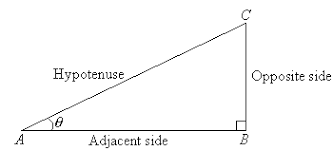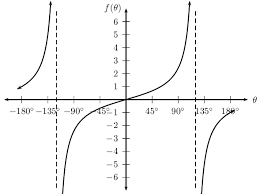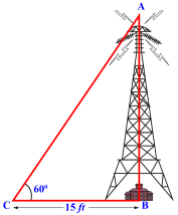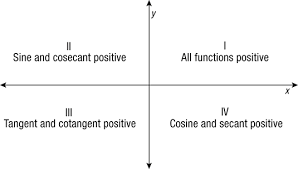The tangent function ‘or’ Tan Theta is one of the three most common trigonometric functions, along with sine and cosine. The tangent function in a right-angle triangle is defined as the ratio of the opposite side to the adjacent side.

The mathematical denotation of the tangent is,
\(\tan(\theta) = \frac{\text{Opposite Side}}{\text{Adjacent Side}}\)Index
More About Tan Theta
Tan theta formula can also be calculated from the ratio of the sine of the angle to the cosine of the angle.
\(\tan(\theta) = \frac{\sin(\theta)}{\cos(\theta)}\)
The derivative of \(\tan(\theta)\) in calculus is \(\sec^2(\theta)\) and the integral of it is \(\ln|\cos(\theta)|\). The reciprocal of tan theta is \(\cot(\theta)\).

Below is a table of tan theta values for different degrees and radians.
| Radians | Degree | Tangent Value |
| 0 | 0° | 0 |
| \(\frac{\pi}{6}\) | 30° | \(\frac{\sqrt{3}}{3}\) |
| \(\frac{\pi}{4}\) | 45° | 1 |
| \(\frac{\pi}{3}\) | 60° | \(\sqrt{3}\) |
| \(\frac{\pi}{2}\) | 90° | \(\infty\) |
| \(\pi\) | 180° | 0 |
| \(\frac{3\pi}{2}\) | 270° | \(\infty\) |
| \(2\pi\) | 360° | 0 |
Important Tan Theta Formula
Some important properties of the tangent and tan theta formula are:
- \(\tan(-x) = -\tan(x)\)
- \(\tan(90° – x) = \cot(x)\)
- \(\tan(x + \pi) = \tan(x)\)
- \(\tan(\pi – x) = -\tan(x)\)
- \(\tan^2(x) = \sec^2(x)-1\)
- \(tan(x + y) = \frac{\tan(x) + \tan(y)}{1 – \tan(x)*\tan(y)}\)
- \(tan(x – y) = \frac{\tan(x) – \tan(y)}{1 + \tan(x)*\tan(y)}\)
- \(\tan(2x) = \frac{2 \tan(x)}{1 – \tan^2(x)}\)
- \(\tan(3x) = \frac{3 \tan(x) – tan^3(x)}{1 – 3 \tan^2(x)}\)
- \(\tan(\frac{x}{2}) = \sqrt{\frac{1 – \cos(x)}{1 + \cos(x)}} = \frac{1 – \cos(x)}{\sin(x)} = \frac{\sin(x)}{1 + \cos(x)}\)
Solved Examples
Question 1. If \(\sin(x) = \frac{4}{5}\), calculate the value of \(\tan(x)\).
Solution. Using trigonometric identity,
\(\cos^2(x) = 1 – \sin^2(x) = 1 – \frac{16}{25}\)
\(\cos^2(x) = \frac{9}{25}\)
\(\cos(x) = \frac{3}{5}\)
Now,
\(\tan(x) = \frac{\sin(x)}{\cos(x)} = \frac{4/5}{3/5}\)
\(∴ \tan(x) = \frac{4}{3}\)
Question 2. If \(\sec(x) = \frac{5}{8}\), calculate the value of \(\tan(x)\).
Solution. Using trigonometric identity,
\(\begin{align}
\tan^2(x) & = \sec^2(x) – 1\\
& = \frac{5}{8}^2 – 1\\
& = \frac{25}{64} – 1\\
& = -\frac{39}{64}\\
\tan(x) & = \sqrt{-\frac{39}{64}}\\
\end{align}
\)
Question 3. John is standing on the ground and looking at the top of a tower with an angle of elevation of 60°. The distance between John and the tower is 15 feet. Calculate the height of the tower.

Solution. As we know,
\(\tan(\theta) = \frac{\text{Opposite}}{\text{Adjacent}}\)
\(\tan(60°) = \frac{\text{Opposite}}{\text{15}}\)
\(\sqrt{3} = \frac{\text{Opposite}}{\text{15}}\)
\(\text{Opposite} = 15 \sqrt{3}\)
∴ The height of the tower is \(15 \sqrt{3}\) feet.
FAQs
As we know, \(\tan(x) = \frac{\sin(x)}{\cos(x)}\)
The angle (-x) lies in the 4th quadrant of a graph, and sine is negative in this quadrant. Hence, this shows that tan(-x) = -tan(x).
Tan theta of a right-angled triangle is equal to the ratio of the length of the opposite side to the length of the adjacent side. It is also equal to the ratio of the sine of the angle and the cosine of the angle.

It can be observed from the above graph that tan(x) is positive in the 1st and 3rd quadrants and negative in the 2nd and 4th quadrants.
More Trigonometric Function
